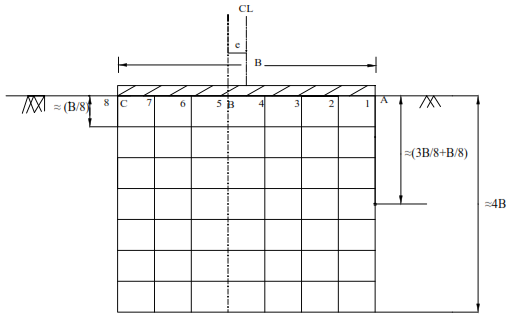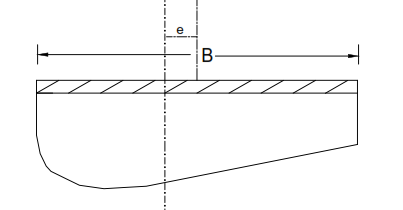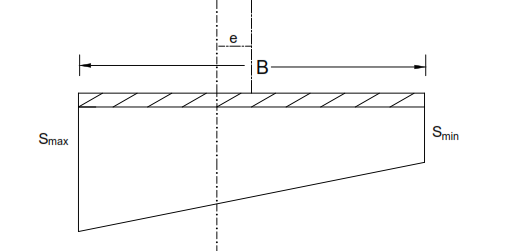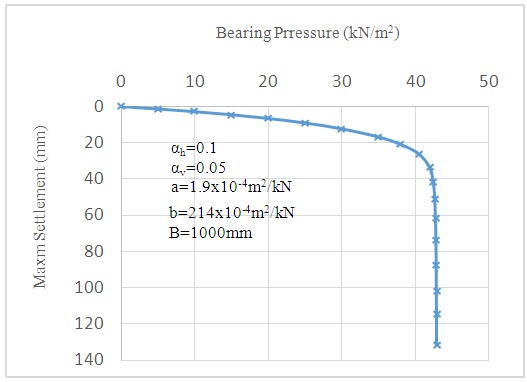Tinku Biswas, Swami Saran, Daya Shanker
Department of Earthquake Engineering, Indian Institute of Technology, Roorkee, India
Correspondence to: Daya Shanker, Department of Earthquake Engineering, Indian Institute of Technology, Roorkee, India.
| Email: |  |
Copyright © 2016 Scientific & Academic Publishing. All Rights Reserved.
This work is licensed under the Creative Commons Attribution International License (CC BY).
http://creativecommons.org/licenses/by/4.0/

Abstract
In this paper, a novel Pseudo-static analysis approach has been presented to obtain pressure-settlement and pressure-tilt curves of a strip footing located in seismic region and resting on clay. Knowing these two curves, ultimate bearing capacity, settlement and tilt at the required pressure intensity can be obtained which in turn on comparing with their permissible limits helps in its proportioning. Both the horizontal and vertical seismic coefficients have been considered.
Keywords:
Bearing capacity, Settlement, Constitutive law
Cite this paper: Tinku Biswas, Swami Saran, Daya Shanker, Behavior of a Strip Footing Resting on Clay Using Non-linear Constitutive Law, Geosciences, Vol. 6 No. 3, 2016, pp. 75-77. doi: 10.5923/j.geo.20160603.01.
1. Introduction
A foundation engineer frequently comes across the problems of designing footings located in seismic regions. In Pseudo-static analysis due to seismic forces, the base of such foundation is subjected to an eccentric-inclined load as the horizontal seismic force  acting at a height a results a shear and moment at the base of footing. Total vertical load will be
acting at a height a results a shear and moment at the base of footing. Total vertical load will be  are respectively the vertical load, vertical and horizontal seismic coefficients.Hence, the base of the footing is subjected to a horizontal stress
are respectively the vertical load, vertical and horizontal seismic coefficients.Hence, the base of the footing is subjected to a horizontal stress  and vertical pressure diagram as shown in Fig.1
and vertical pressure diagram as shown in Fig.1 | Figure 1. Applied stresses at the base of the footings |
Here,  h is the height of the force
h is the height of the force  above the base of footing In the present paper, an approach is presented for obtaining pressure- settlement and pressure tilt characteristic curves of a strip footing resting on clay using its non-linear constitutive law. From these curves, ultimate bearing capacity, settlement and tilt of the footing may be obtained in a more realistic method. Accuracy of the method depends on the valuation of the constitutive law. This enables the complete proportioning the footing in more rational way. The methodology given in the paper is based on the work carried out by Sharan (1977) and Agarwal (1986) for static loads.
above the base of footing In the present paper, an approach is presented for obtaining pressure- settlement and pressure tilt characteristic curves of a strip footing resting on clay using its non-linear constitutive law. From these curves, ultimate bearing capacity, settlement and tilt of the footing may be obtained in a more realistic method. Accuracy of the method depends on the valuation of the constitutive law. This enables the complete proportioning the footing in more rational way. The methodology given in the paper is based on the work carried out by Sharan (1977) and Agarwal (1986) for static loads.
2. Analysis
AssumptionFollowing assumptions have been in the analysis.1) The soil mass has been assumed as semi-infinite and isotropic medium.2) The whole soil mass supporting a footing has been divided into a large number of thin horizontal strips (Fig. 2) in which stresses and strains have been obtained along any vertical section.3) a) The stresses in each layer have been computed using Boussinesq’s theory as the stress equations for various types of loads are available. b) The strains have been computed from the known stress condition using constitutive law of soil. | Figure 2. Soil strata divided into n-horizontal strips (Biswas, 2016) |
ProcedureProcedure of the analysis is described in following steps:i) Divide the soil strata in thin layers upto significant depth (≈4.0B). Thickness of each layer may be taken equal to B/8, B bearing the width of footing.ii) Applied stress are taken as shown in Fig. 1iii) Select about eight points on the base of footing including points A, B, and C. Further procedure is to determine the values of settlements of these points. For this, consider a vertical section passing though the any of the selected points.iv) For determining the settlement of the selected point on the base of footing, determine the settlement of each layer at that point. For example, consider fourth layer and vertical section passing though point ‘A’ depth of the centre of this layer below base of footing will be  .Determine the stresses
.Determine the stresses  at this point due to applied stress (Fig.1) using theory of elasticity.v) In case of clayes value of principal strain
at this point due to applied stress (Fig.1) using theory of elasticity.v) In case of clayes value of principal strain  in the direction major principal stress may be obtained as per Eq.(1)
in the direction major principal stress may be obtained as per Eq.(1) | (1) |
Where a and b are Kondner’s hyperbola constants. Their values may be obtained by performing drained triaxial tests at confining pressure  .
. | (2a) |
 | (2b) |
 | (2c) |
 is Poisson’s ratiovi) Vertical strain at the selected point will then be:
is Poisson’s ratiovi) Vertical strain at the selected point will then be: | (3) |
vii) On multiplying  with the thickness of the strip, settlement of the strip at the point under consideration is obtained. The evaluation of the total settlement along any vertical section is done by numerically integrating the quantity i.e.Where
with the thickness of the strip, settlement of the strip at the point under consideration is obtained. The evaluation of the total settlement along any vertical section is done by numerically integrating the quantity i.e.Where  | (4) |
St = total settlement along ith vertical section, =vertical strain at depth z below the base of footing.dz = thickness of strips at depth z, andn = number of strips in which the soil strata upto significant depth is divided. In this way values of total settlements along other vertical sections passing through the base of footing are obtained. Settlement pattern will be as shown in Fig. (3a).viii) Considering the base of the footing as rigid its settlement pattern should be as shown in Fig.(3b). Values of Smax and Smin may be obtained solving the following two equations.
=vertical strain at depth z below the base of footing.dz = thickness of strips at depth z, andn = number of strips in which the soil strata upto significant depth is divided. In this way values of total settlements along other vertical sections passing through the base of footing are obtained. Settlement pattern will be as shown in Fig. (3a).viii) Considering the base of the footing as rigid its settlement pattern should be as shown in Fig.(3b). Values of Smax and Smin may be obtained solving the following two equations. | (5a) |
 | (5b) |
A = area of settlement diagram shown in Fig (3a), and = distance of
= distance of  of settlement diagram shown in Fig (3b) from left edge of footing.Tilt of the footing may then be obtained as below:
of settlement diagram shown in Fig (3b) from left edge of footing.Tilt of the footing may then be obtained as below: | (6) |
 | Figure 3a. Settlement Diagram (flexible footing) |
 | Figure 3b. Settlement Diagram (rigid footing) |
3. Discussion and Conclusions
Using the above methodology pressure versus maximum settlement curves (q-Smax) were obtained using the soil parameters of Buckshot clay Fig (4) shows a curve for
Fig (4) shows a curve for And
And 
 | Figure 4. Pressure versus maximum settlement curves for rigid strip footing |
Similar curves for other values of  and B were obtained but not shown herein due to space limitation. Curves for pressure versus minimum settlement and pressure versus tilt were obtained:i) Ultimate bearing capacity of the footing decreases with the increase in both
and B were obtained but not shown herein due to space limitation. Curves for pressure versus minimum settlement and pressure versus tilt were obtained:i) Ultimate bearing capacity of the footing decreases with the increase in both  and h/B values.ii) Both maximum settlement and tilt increase with the increase in
and h/B values.ii) Both maximum settlement and tilt increase with the increase in  and h/B values.iii) Minimum settlement decreases with the increase in the values of both
and h/B values.iii) Minimum settlement decreases with the increase in the values of both  and h/B.
and h/B.
ACKNOWLEDGEMENTS
This is a part of the thesis work. The first author (TB) is indebted to Head, Department of Earthquake Engineering, IIT Roorkee, Roorkee for excellent computational facilities to carry out the work.
References
| [1] | Agarwal, R.K. (1986), “Behaviour of Shallow Foundations Subjected To Eccentric-Inclined Loads” Ph.D Thesis, University of Roorkee, Roorkee. |
| [2] | Meyerhof, G.G. (1951.), “Ultimate Bearing Capacity of Foundation”, Geotechnique, Vol.2, N0.4, pp.301-331. |
| [3] | Saran, Swami, D. Shanker, and Tinku Biswas (2016). "Proportioning of a Strip Footing Located In Seismic Region Using Non-Linear Constitutive Law Of Sand." |
| [4] | Sharan, U.N. (1977) “Pressure-settlement characteristics of surface footing from constitutive laws” Ph.D Thesis, University of Roorkee, Roorkee. |
| [5] | Terzaghi, K. (1943), “Theoretical Soil Mechanics, John Willey and Sons”, Inc. N.Y.1943. |
| [6] | Terzaghi, K. and Peck, R. B. (1967), “Soil Mechanics in Engineering Practice”, John Wiley and Sons Inc. New York, 1967. |



 acting at a height a results a shear and moment at the base of footing. Total vertical load will be
acting at a height a results a shear and moment at the base of footing. Total vertical load will be  are respectively the vertical load, vertical and horizontal seismic coefficients.Hence, the base of the footing is subjected to a horizontal stress
are respectively the vertical load, vertical and horizontal seismic coefficients.Hence, the base of the footing is subjected to a horizontal stress  and vertical pressure diagram as shown in Fig.1
and vertical pressure diagram as shown in Fig.1
 h is the height of the force
h is the height of the force  above the base of footing In the present paper, an approach is presented for obtaining pressure- settlement and pressure tilt characteristic curves of a strip footing resting on clay using its non-linear constitutive law. From these curves, ultimate bearing capacity, settlement and tilt of the footing may be obtained in a more realistic method. Accuracy of the method depends on the valuation of the constitutive law. This enables the complete proportioning the footing in more rational way. The methodology given in the paper is based on the work carried out by Sharan (1977) and Agarwal (1986) for static loads.
above the base of footing In the present paper, an approach is presented for obtaining pressure- settlement and pressure tilt characteristic curves of a strip footing resting on clay using its non-linear constitutive law. From these curves, ultimate bearing capacity, settlement and tilt of the footing may be obtained in a more realistic method. Accuracy of the method depends on the valuation of the constitutive law. This enables the complete proportioning the footing in more rational way. The methodology given in the paper is based on the work carried out by Sharan (1977) and Agarwal (1986) for static loads.
 .Determine the stresses
.Determine the stresses  at this point due to applied stress (Fig.1) using theory of elasticity.v) In case of clayes value of principal strain
at this point due to applied stress (Fig.1) using theory of elasticity.v) In case of clayes value of principal strain  in the direction major principal stress may be obtained as per Eq.(1)
in the direction major principal stress may be obtained as per Eq.(1)
 .
.


 is Poisson’s ratiovi) Vertical strain at the selected point will then be:
is Poisson’s ratiovi) Vertical strain at the selected point will then be:
 with the thickness of the strip, settlement of the strip at the point under consideration is obtained. The evaluation of the total settlement along any vertical section is done by numerically integrating the quantity i.e.Where
with the thickness of the strip, settlement of the strip at the point under consideration is obtained. The evaluation of the total settlement along any vertical section is done by numerically integrating the quantity i.e.Where 
 =vertical strain at depth z below the base of footing.dz = thickness of strips at depth z, andn = number of strips in which the soil strata upto significant depth is divided. In this way values of total settlements along other vertical sections passing through the base of footing are obtained. Settlement pattern will be as shown in Fig. (3a).viii) Considering the base of the footing as rigid its settlement pattern should be as shown in Fig.(3b). Values of Smax and Smin may be obtained solving the following two equations.
=vertical strain at depth z below the base of footing.dz = thickness of strips at depth z, andn = number of strips in which the soil strata upto significant depth is divided. In this way values of total settlements along other vertical sections passing through the base of footing are obtained. Settlement pattern will be as shown in Fig. (3a).viii) Considering the base of the footing as rigid its settlement pattern should be as shown in Fig.(3b). Values of Smax and Smin may be obtained solving the following two equations.

 = distance of
= distance of  of settlement diagram shown in Fig (3b) from left edge of footing.Tilt of the footing may then be obtained as below:
of settlement diagram shown in Fig (3b) from left edge of footing.Tilt of the footing may then be obtained as below:


 Fig (4) shows a curve for
Fig (4) shows a curve for And
And 

 and B were obtained but not shown herein due to space limitation. Curves for pressure versus minimum settlement and pressure versus tilt were obtained:i) Ultimate bearing capacity of the footing decreases with the increase in both
and B were obtained but not shown herein due to space limitation. Curves for pressure versus minimum settlement and pressure versus tilt were obtained:i) Ultimate bearing capacity of the footing decreases with the increase in both  and h/B values.ii) Both maximum settlement and tilt increase with the increase in
and h/B values.ii) Both maximum settlement and tilt increase with the increase in  and h/B values.iii) Minimum settlement decreases with the increase in the values of both
and h/B values.iii) Minimum settlement decreases with the increase in the values of both  and h/B.
and h/B. Abstract
Abstract Reference
Reference Full-Text PDF
Full-Text PDF Full-text HTML
Full-text HTML